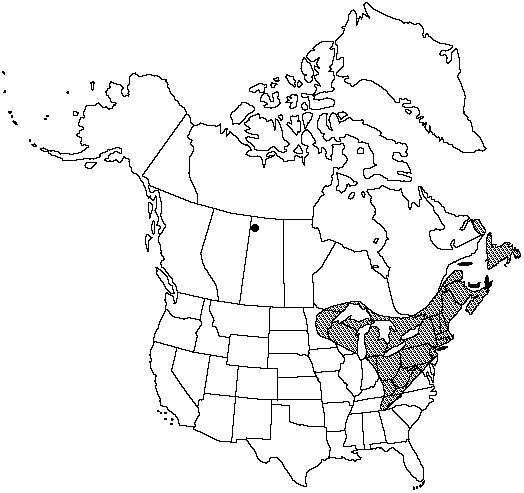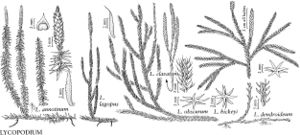Difference between revisions of "Lycopodium hickeyi"
Beitel, & R. C. Moran, Amer. Fern J. 79: 119–121. 1989.
FNA>Volume Importer |
GeoffLevin (talk | contribs) m (Fixed Nfld. and Labr. distribution to match printed version.) |
||
| (3 intermediate revisions by 2 users not shown) | |||
| Line 26: | Line 26: | ||
|habitat=Mainly in hardwood forests and second-growth, shrubby habitats | |habitat=Mainly in hardwood forests and second-growth, shrubby habitats | ||
|elevation=0–1600 m | |elevation=0–1600 m | ||
| − | |distribution=N.B.;Nfld.;N.S.;Ont.;P.E.I.;Que.;Sask.;Conn.;Ind.;Ky.;Maine;Md.;Mass.;Mich.;Minn.;N.H.;N.J.;N.Y.;N.C.;Ohio;Pa.;R.I.;Tenn.;Vt.;Va.;W.Va.;Wis. | + | |distribution=N.B.;Nfld. and Labr.;N.S.;Ont.;P.E.I.;Que.;Sask.;Conn.;Ind.;Ky.;Maine;Md.;Mass.;Mich.;Minn.;N.H.;N.J.;N.Y.;N.C.;Ohio;Pa.;R.I.;Tenn.;Vt.;Va.;W.Va.;Wis. |
|discussion=<p>The range of <i>Lycopodium hickeyi</i> overlaps with that of <i>L. obscurum</i> and extends considerably north and west of that species. Although the arrangement of the leaf ranks is similar to that of <i>L. obscurum</i>, the leaf dimorphy and the ascending orientation and absence of twisting of the leaves are diagnostic. Where ranges of two or three species overlap, indivual species retain their identities, indicating that their critical differences have a genetic basis.</p> | |discussion=<p>The range of <i>Lycopodium hickeyi</i> overlaps with that of <i>L. obscurum</i> and extends considerably north and west of that species. Although the arrangement of the leaf ranks is similar to that of <i>L. obscurum</i>, the leaf dimorphy and the ascending orientation and absence of twisting of the leaves are diagnostic. Where ranges of two or three species overlap, indivual species retain their identities, indicating that their critical differences have a genetic basis.</p> | ||
|tables= | |tables= | ||
| Line 44: | Line 44: | ||
|habitat=Mainly in hardwood forests and second-growth, shrubby habitats | |habitat=Mainly in hardwood forests and second-growth, shrubby habitats | ||
|elevation=0–1600 m | |elevation=0–1600 m | ||
| − | |distribution=N.B.;Nfld.;N.S.;Ont.;P.E.I.;Que.;Sask.;Conn.;Ind.;Ky.;Maine;Md.;Mass.;Mich.;Minn.;N.H.;N.J.;N.Y.;N.C.;Ohio;Pa.;R.I.;Tenn.;Vt.;Va.;W.Va.;Wis. | + | |distribution=N.B.;Nfld. and Labr.;N.S.;Ont.;P.E.I.;Que.;Sask.;Conn.;Ind.;Ky.;Maine;Md.;Mass.;Mich.;Minn.;N.H.;N.J.;N.Y.;N.C.;Ohio;Pa.;R.I.;Tenn.;Vt.;Va.;W.Va.;Wis. |
|reference=None | |reference=None | ||
|publication title=Beitel, & R. C. Moran, Amer. Fern J. | |publication title=Beitel, & R. C. Moran, Amer. Fern J. | ||
|publication year=1989 | |publication year=1989 | ||
|special status= | |special status= | ||
| − | |source xml=https:// | + | |source xml=https://bitbucket.org/aafc-mbb/fna-data-curation/src/2e0870ddd59836b60bcf96646a41e87ea5a5943a/coarse_grained_fna_xml/V2/V2_722.xml |
|genus=Lycopodium | |genus=Lycopodium | ||
|species=Lycopodium hickeyi | |species=Lycopodium hickeyi | ||
Latest revision as of 22:37, 20 February 2024
Horizontal stems subterranean. Upright shoots treelike, many branched, branchlets numerous and strongly differentiated; annual bud constrictions absent; leaves on main axis below lateral branchlets tightly appressed, dark green, needlelike, 3.5–4.5 × 0.5–0.6 mm, soft. Lateral branchlets round in cross section, 4–7 mm diam.; annual bud constrictions inconspicuous; leaves ascending, in 6 ranks, 1 on upperside, 4 lateral, and 1 on underside, equal in size, linear, widest in middle; margins entire; apex acuminate, lacking hair tip. Strobili sessile, 1–7 per upright shoot, 15–65 mm. Sporophylls 3–3.5 × 2–2.5 mm, apex long, gradually narrowing to tip. 2n = 68.
Habitat: Mainly in hardwood forests and second-growth, shrubby habitats
Elevation: 0–1600 m
Distribution

N.B., Nfld. and Labr., N.S., Ont., P.E.I., Que., Sask., Conn., Ind., Ky., Maine, Md., Mass., Mich., Minn., N.H., N.J., N.Y., N.C., Ohio, Pa., R.I., Tenn., Vt., Va., W.Va., Wis.
Discussion
The range of Lycopodium hickeyi overlaps with that of L. obscurum and extends considerably north and west of that species. Although the arrangement of the leaf ranks is similar to that of L. obscurum, the leaf dimorphy and the ascending orientation and absence of twisting of the leaves are diagnostic. Where ranges of two or three species overlap, indivual species retain their identities, indicating that their critical differences have a genetic basis.
Selected References
None.
